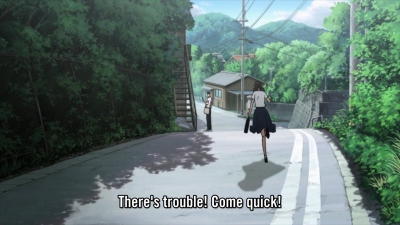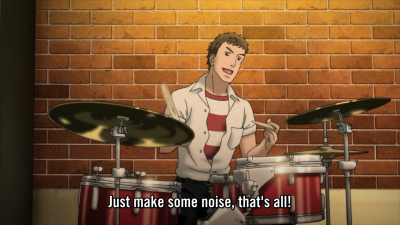Sakamichi no Apollon: Kids on the Slope Episode 2
Wow, it’s only the second episode of Sakamichi no Apollon, and I’m already 4 days late? Not a good sign, but I’m only now beginning to realize the brutal pace of weekly episodic posts. On to the episode.
The episode loses some of that very genuine, uncontrived feel of the first one, if just a little. In the last episode, the screenplay unfolded more naturally, and events seemed to occur logically without seeming over-explained or too convenient, so to speak.
The conflict with Yamaoka was adequately foreshadowed when he craned his neck to see Kaoru flirting with Ritsuko the previous episode, but did Sentarou really have to come barreling to his rescue at the last minute after being tipped off by Ritsuko? Though not necessarily out of character for the show, this sequence came off as too coincidental and forced. Kaoru, getting taken away by the bullies, just happened to be seen by Ritsuko, who just happened to run and find Sentaro in time, who just happened to know exactly where the place was. It’s little conveniences in writing like this that force me to stretch my belief that begin to take me out of a show.
Still, if Sakamichi is willing to trade the tiniest bit of believability to facilitate substantial character development, that’s something I’m willing to accept.
What was harder for me to acknowledge was that the story’s answer to the potentially brewing love triangle was to avoid it entirely. Though Ritsuko and Sentaro’s purely childhood-friend relationship was made pretty clear from the outset, a love triangle felt almost inevitable, and I felt it could have made for some interesting character progression. The scene at the conclusion of their beach trip made Sentaro’s infatuation totally obvious and felt like a cop-out that dodged the seemingly-obvious relationship question at hand.
Avoiding it, in the end, feels better in keeping with the spirit of the show, but I mourn the death of the now-absent sole source of potential lasting external conflict in the story.
Also, we learn that Sentaro and Ritsuko are Christians that attend church on Sundays. I’m sure this has some deep, profound literary significance to the story, but you’re reading Anime Instrumentality, so I’ll go ahead and talk a bit about the music.
I think I finally get this show’s approach to its score. What the soundtrack is trying to do is very different from what we’ve grown used to from jazz-oriented OST’s in the past. Jazz scores like Cowboy Bebop and even this season’s Lupin basically hit the viewer over the head with jazz from the getgo. It’s used more like a traditional soundtrack in those cases; jazz was more the result of the story material, enabling and strengthening the plot.
In Kids on the Slope, though, jazz is the plot. It’s the subject matter itself rather than that which facilitates it. The show is less about jazz than it is about some kids growing up by playing and learning and living it, and that’s where the difference lies. Like many have mentioned, the jazz in this show isn’t some static constant we take for granted that drapes the show at every instance. Rather, it’s a living, breathing part of the narrative.
Whenever jazz has been sounded so far in Sakamichi no Apollon, it was to mark an event that represented significant development within the plot or for the characters, something that challenged the status quo and evidenced some kind of change.
With that in mind, I think that’s why I enjoy the OP and ED so much now. They’re good songs, and my previous expectations weren’t where they needed to be. Sakamichi’s OP and ED don’t have jazz in them for the same reason “Tank!” and “The Real Folk Blues” didn’t have gunshots and karate kicks in them, but I admit that’s spreading my point a bit thin.
The jam session depicted in the episode is a remarkably accurate depiction of what it’s like to play in a small combo setting. In particular, it captured the awkwardness and slow loosening-up of a player that really has no idea what he’s doing.
That sense of dread when you don’t know what chord is being sounded as other players hammer on ahead around you is fairly well portrayed here, and I doubt a better representation of it exists in anime. I say “fairly” because I’m incredulous that a total rookie like Kaoru would have the ear to at least play the right progression after catching up with the rest of the group, as it does sound like he’s playing the right chords, if in the totally wrong style. A production consideration, most likely, as to be totally faithful to what a “lost musician” sounds like would be to have the harmony train wreck entirely.
I liked the way the tune just organically sprouted out of the moment as opposed to having some bland count-in start the tune. That’s more in keeping with the atmosphere of a live gig, and is a subtle hint at how familiar the musicians are with one another. What also felt organic in that vein is the slow evolution of Kaoru’s playing from just stamping out triads to running up scales to eventually sprinkling in some call and response with the trumpet. The running up a scale bit is especially spot-on, as climbing up scale tones is a natural crutch that new jazz students tend to use to introduce some kind of motion to their improvised playing without having to think too much.
Sometimes, though, you just have to toss your apprehensions out the window and start belting notes out like you don’t even care about sounding bad. That seems to be the moral crux behind the episode – the first step is often the most difficult one, but sometimes the only way to deal with your fears is to confront them.
Sometimes you just have to go out there and make some noise despite yourself. In an extension of the themes I discussed from the first episode about the two male leads’ approaches to life, just as Kaoru found the rain to be not as bad as he thought, his first brave steps into jazz represent his initial foray into a new worldview. Well, he looks like he’s having a good time, yeah?
It’s interesting to note how the show paralleled the real-life, as it were, Kaoru to the musical one. The jam session is mirrored to a large extent by the fight scene earlier in the show. In both sequences, Kaoru learns to step out of his shell, first by participating in the fisticuffs (and failing comically) and then by joining in on the music. Now, with the developments with Sentaro and his love interest, I suspect he will show some character growth as well.
Behind the scenes, I find it hilarious and intriguing that a professional session musician like the one who played Kaoru’s part in the studio would be told to actively tone down his skill level as to mimic a total amateur as a directorial concern. Even when trying to play “badly,” evidence of the players’ skill still peek out occasionally, especially in little, stylistic techniques. It’s sort of like when an artist in an animation studio is told to draw a “bad” drawing intended to be something that a character drew, but the drawing is still pretty darn good by most standards.
This post is getting pretty long, so I’ll conclude it here. In summary, the Sakamichi no Apollon is still going strong in terms of characterization, but is falling victim to a lot of the tropes of a more typical romantic dramedy.
This week, I leave you, not with a musical performance, but with a short video of legendary jazz guitarist Pat Metheny speaking the gospel of the truth behind Kenny G and smooth jazz.
This is a public service by your friends here at Anime Instrumentality, the need for which was realized in a short exchange of comments on the episode 1 post.

![[HorribleSubs] Sakamichi no Apollon - 02 [1080p].mkv_snapshot_10.21_[2012.04.23_22.24.38]](https://blog.animeinstrumentality.net/wp-content/uploads/2012/04/HorribleSubs-Sakamichi-no-Apollon-02-1080p.mkv_snapshot_10.21_2012.04.23_22.24.38-600x337.jpg)

![[HorribleSubs] Sakamichi no Apollon - 02 [1080p].mkv_snapshot_21.04_[2012.04.23_22.40.59]](https://blog.animeinstrumentality.net/wp-content/uploads/2012/04/HorribleSubs-Sakamichi-no-Apollon-02-1080p.mkv_snapshot_21.04_2012.04.23_22.40.59-400x225.jpg)
![[HorribleSubs] Sakamichi no Apollon - 02 [1080p].mkv_snapshot_10.11_[2012.04.23_22.59.16]](https://blog.animeinstrumentality.net/wp-content/uploads/2012/04/HorribleSubs-Sakamichi-no-Apollon-02-1080p.mkv_snapshot_10.11_2012.04.23_22.59.16-400x225.jpg)

![[HorribleSubs] Sakamichi no Apollon - 02 [1080p].mkv_snapshot_11.06_[2012.04.23_22.17.51]](https://blog.animeinstrumentality.net/wp-content/uploads/2012/04/HorribleSubs-Sakamichi-no-Apollon-02-1080p.mkv_snapshot_11.06_2012.04.23_22.17.51-400x225.jpg)
Oh god, I still remember my first time trying to improv. Just play the notes in the scale, they said. Start the measure with the chord’s root note, they said. When you’re a complete newb, all that stuff just flies by you so quickly that you get overwhelmed by all the supposed theory involved in fitting the solo with the chords. Just gotta keep working on it. Keep playing. Play really crappy solos until they don’t sound crappy any more. It’s the same with a lot of things, but the process involved in improvement is quite astounding indeed.
It really is just as you say. Soloing in jazz is something incredibly spontaneous and instantaneous that requires hours and hours of careful study and practice. It really is true how everything just turns into mush when you’re thrown into the setting.
One of the things that jumped out to me the most was just how awkward the piano sounded during the breakout jazz session which I thought captured Kaoru’s outsider-y designation pretty well. I do wonder if we’re going to see jazz used to symbolize how well he’ll be able to integrate with the group, and, by extension, the new town that he’ll become a part of.
I think it was partly what you describe, and partly that the production purposely mixed in the piano very loudly there to make it stand out. Being able to play jazz well really is a careful combination of being able to blend in and contribute to the whole while being able to stand out and offer your individual take on what’s going on. It’s the same in life, really, as people are always trying to feel accepted and socially “with it” while trying to be their own person with their own distinct personality.
This show puts me on good mood. The characters feel so real and the interaction between them is really pleasent to watch. Add some excellent music and beautiful visuals to the mix and you got a damn good anime.
Also that live session scene was so beautiful. I can repeat myself 100 times but the animation was just gorgeous and it really felt like you were down in the basement with them.
I admit the animation while they were playing was really well done, but it loses some of that fidelity frame-by-frame. When I was looking for a good shot to put as the eyecatch, it was difficult to find a solid single frame. It’s to be expected, really, and it’s no fault to the show.
Pingback:Sakamichi no Apollon: Kids on the Slope Episode 3
just to be honest,this series started out kind of boring to me but i realized this is something that would gave me the satisfaction,story-wise…it’s definitely a good break from all those too fictional characters of most series…this series has definitely lived up to the expectations from the award it has been given… 🙂